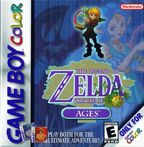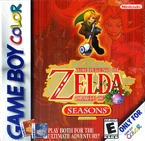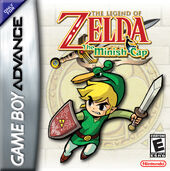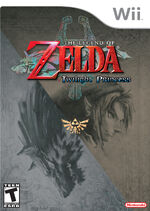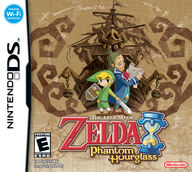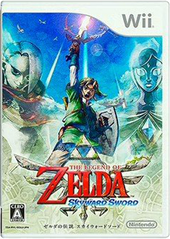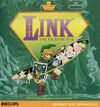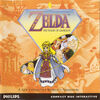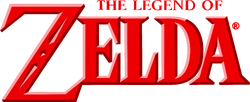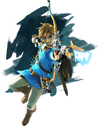- This article is about the series as a whole. For information on the first game in the series, see The Legend of Zelda. For other uses, see The Legend of Zelda (Disambiguation).


The previous international logo for The Legend of Zelda from 1991-2016
The Legend of Zelda is an action-adventure video games media franchise by Nintendo that usually takes place in the fictional medieval-inspired Kingdom of Hyrule,[2] often led by the titular Princess Zelda. The main protagonist of the series is Link, a child or young man who is destined, in most of the games, to save Hyrule from the clutches of the evil warlock Ganondorf or his alter-ego, the fearsome dark beast Ganon, the main antagonist. Some of the games feature additional protagonists such as Navi the fairy, Ezlo the talking cap, or Midna the Twili, who serve as sidekicks throughout the course of the game, or different antagonists, such as Vaati the Wind Mage, the General of Darkness General Onox, or the Usurper King Zant.
The very first game of The Legend of Zelda series is the 1986 Nintendo Entertainment System game, The Legend of Zelda. It was developed concurrently with Super Mario Bros, released one year prior, and intended to be its polar opposite in gameplay, as it focuses on non-linearity. From the start, The Legend of Zelda has had various parallels to the Super Mario franchise, which were both created by the same development team. For example, various Super Mario enemies have frequently appeared in The Legend of Zelda games, although rarely vice versa, and recurring Super Mario elements like Chain Chomps and Fire Bars were even originally created for The Legend of Zelda before they were given their prime association to the fellow Nintendo franchise. While it has never been stated outright by Nintendo, due to the many Easter Eggs, the connections between The Legend of Zelda and Super Mario suggest them to be partner franchises, nearly among the likes of Yoshi, Wario, and Donkey Kong.
Overall, being one of Nintendo's flagship series, The Legend of Zelda is one of the most successful video game franchises, and has sold over 163 million copies as of March 2024; more detailed information on the sales of the series can be found here.
Early years (1986-1997)[]
The Legend of Zelda[]
The Legend of Zelda, the title that introduced the longtime franchise, was first released in Japan in 1986 for the Famicom Disk System, and internationally in 1987 for the NES. The North American release is well-known for having unique gold cartridges rather than gray, and its package has a small portion of the box cut to reveal the cartridge. Though basic by today's standards and in comparison to most later installments of the franchise, the original The Legend of Zelda game was revolutionary for its time. Its Innovations include the ability to use dozens of different items, a vast world full of secrets to explore, and the cartridge's ability to save progress via battery-backed memory (which was a novelty at the time, as most games then well into the 1990s only used passwords or cannot remember progress at all). The game also features a more challenging "Second Quest", accessible upon completing the game or if players set their name as "ZELDA", where dungeons and the placement of items are completely different and enemies are stronger, though the overworld remains mostly identical. Besides the game's technical innovations, the gameplay (finding items and using them to solve puzzles, battling monsters in real-time, and exploring a vast environment) was a successful formula and became widely copied onto later games and other series inspired by it. The Legend of Zelda was wildly popular in Japan and North America during its release, selling 6.5 million copies worldwide, and many to this day consider it one of the most important video games ever made. The first Zelda is noticeable for not featuring the full Triforce in the game, as only the Power and Wisdom pieces existed (although the Courage one is seen in official artwork).
During the late years of the Famicom, in 1994, the game was re-released in standard cartridge format (which omits the FDS' unique sounds). A modified 16-bit version known as BS The Legend of Zelda was released for the Super Famicom's satellite-based expansion, Satellaview, in 1995. BS Zelda no Densetsu was re-released for the Satellaview in 1997 with re-arranged dungeons and a re-arranged overworld (more or less like the "Second Quest" in the original game). This re-release was dubbed BS Zelda ~MAP 2~.
The Adventure of Link[]
The second game, the direct sequel to the first, known as Zelda II: The Adventure of Link (making it the first and so far only Zelda game not to directly have "Zelda" in the title) was released in 1987 in Japan (again on the FDS) and 1988 internationally, and was a departure from the concept of the first game as well as all later titles. It exchanged the top-down perspective for side-scrolling and introduced RPG elements (e.g., experience points) not found in any other Zelda installments, and the gameplay itself was comparable to the Castlevania series released on the NES at the time. It is also the only Zelda title until Four Swords Adventures in which Link does not collect Rupees. Because of these fundamental changes exclusive to this game, as well as having a notoriously high difficulty, many consider The Adventure of Link the "black sheep" of the series. In spite of this, the game was still successful, as it sold 4.38 million copies. Like its predecessor, this game was notable for its gold-colored cartridges and cut-out box in the North American release. This is an irony as both games were later re-released in the final years of the NES with normal gray cartridges that happen to be more difficult to find than their initial gold counterparts. The Adventure of Link is the first game in the series where the main antagonist is not Ganon, as instead the Final Boss of this installment is Link's own evil shadow, Dark Link.
A Link to the Past[]
Four years later, a third title, A Link to the Past (known as Triforce of the Gods in Japan) returned to the top-down view (under a 3/4 perspective) and added an important concept of an alternate dimension to explore, a land known as the Dark World, a concept itself later reused for Ocarina of Time and Twilight Princess. The game was originally released for the Super NES in 1991 in Japan and 1992 for overseas. It is the first installment of the series to have a proper backstory for Link's adventure and the motivation of Ganon, and also introducing the concept of a seemingly main antagonist (Agahnim) before revealing the actual villain. A Link to the Past is widely known for introducing the Master Sword, a highly important weapon for the rest of the series, and is a cult classic among fans - often called the best 2D Zelda game, selling 4.61 million copies worldwide.
It was later re-released for the Game Boy Advance on 2002 in North America, on a cartridge with Four Swords, the first multiplayer Zelda. In addition, both this game (unchanged except for being converted into a downloadable format) and an exclusive "loosely based" sequel (which used the same game engine) called Ancient Stone Tablets were released on the Satellaview in Japan in 1997. In 2013, over two decades after the original release of the game, a sequel to A Link to the Past, A Link Between Worlds, was released for the Nintendo 3DS.
Link's Awakening[]
The next game, Link's Awakening, was the first Zelda title ever released on a handheld console, for the Game Boy in 1993, and is also the first game to take place outside of Hyrule, in the land of Koholint Island. The gameplay of the game itself is similar to that of A Link to the Past, and even shares the same developers, as it was originally intended to be that game's sequel. Although not as influential compared to its predecessor or The Legend of Zelda, it introduced playable songs, fishing, and a trading sequence to the series. Link's Awakening was praised among fans and sold 3.83 million copies worldwide. Link's Awakening is known to have many crossover appearances from various other Nintendo franchises, specifically Super Mario and even Kirby (which was relatively new at the time).
It was re-released for the Game Boy Color in 1998 as Link's Awakening DX, which is identical with color graphics, with some additional features, including an extra color-based dungeon and a photo shop that allowed interaction with the Game Boy Printer. The game would have a 3D remake in 2019 for the Switch.
The 3D Era (1998-2002)[]
Ocarina of Time[]
After another hiatus, the series made the transition to 3D with the next installment of Ocarina of Time, which was released for the Nintendo 64 in 1998. This game, initially known as Zelda 64, retained the core gameplay of the previous 2D games, and quickly became one of the most universally successful games of all time in both commercial and critical terms. Selling 7.6 million copies, it is widely considered by many to this day to be the greatest video game ever created, and scored perfect scores in several video game publications, including the first 40/40 score in Famitsu (a prestigious Japanese gaming magazine). In 2006 it was also ranked by Nintendo Power as the best game to ever appear on a Nintendo console. The title was originally slated for the ill-fated, Japanese-only Nintendo 64DD, but was ported to a 32MB cartridge when the hardware was delayed. It features many then-new innovations, including the use of lock-on targeting, a new gameplay mechanic that focuses the camera on a nearby target and alters the player's actions to be relative to that target, which would become standard for all later 3D-based installments. Such mechanics allow precision-based swordfighting in a 3D space and were a revolutionary development at the time. It also introduced the Light Arrows, which replaced the Silver Arrows in earlier games. Like its NES predecessors, Ocarina of Time was notable for being released on a limited Collector's Edition gold cartridge (available mainly to those who pre-ordered the game) though most were in the traditional gray cartridge. Although Ocarina of Time was considered a masterpiece and has explicit importance in not only in the Zelda series but the video game industry as a whole (alongside Super Mario 64), due to its age today, however, Eiji Aonuma controversially claimed the game didn't age well and would never quit working on the franchise until he created a superior game. Some fans also believed the N64 game to be overrated or overshadowed the potential success of later titles with similar gameplay until Breath of the Wild, implying the series peaked with this particular game.
Ocarina of Time was re-released on the GameCube in 2002 when it was offered as a pre-order incentive for The Wind Waker in the US and Japan. Europe continues to receive it free in every copy of The Wind Waker, except for the discounted Player's Choice version. It included a previously unreleased 64DD expansion known as Ura Zelda in Japan and Master Quest in North America. However the original Ura Zelda planned for the 64DD at the time was to enhance Ocarina of Time in most aspects, instead of being a dungeon remix, which Master Quest is and much like that of the Second Quest in The Legend of Zelda. Ocarina of Time was included as part of Collector's Edition for the GameCube in 2003.
The game was remade in 2011 as Ocarina of Time 3D on the Nintendo 3DS, which added improved graphics and framerate, 3D effects, a Boss Challenge mode and included the Master Quest (with mirrored graphics). It is also re-released on the Nintendo Switch Online in HD resolution.
Majora's Mask[]
The follow-up title of Ocarina of Time, Majora's Mask, which was released in November 2000, used the same 3D game engine as the previous Nintendo 64 game (dropping the fixed 3D elements), but uses the Expansion Pak for slightly improved graphics, adding a unique novel time-based concept. Although critically acclaimed like its predecessor, the in-game 72 hour (54 minutes in real time) time limit feature gained somewhat mixed reactions from the series' fanbase. It was originally called Zelda Gaiden, a Japanese title loosely translating to "Zelda, Another Story". Gameplay, though virtually identical to the previous game, had changed significantly; in addition to a form of time limit, Link could use masks to transform into different creatures with unique skills. While Majora's Mask retained the graphical style of the landmark Ocarina of Time, it was also a departure, particularly in atmosphere; Majora's Mask is one of, if not the darkest installment of the entire series, dealing with death and tragedy in a manner not previously (or later) seen in the franchise, and has a sense of impending doom as a large sinister moon slowly descends upon the land of Termina, a parallel universe of Hyrule. Alongside being a Zelda title not taking place in Hyrule like Link's Awakening, this game is also known for its main antagonist not being Ganon, as Majora's Mask takes his place, similar to The Adventure of Link. All copies of Majora's Mask are gold cartridges, instead of a limited Collector's Edition lenticular cartridge label was offered as the pre-order incentive. Copies of the game that weren't actual Collector's Editions featured the traditional sticker cartridge label rather than a holographic one. As a result of the game being released late in the N64's lifespan and fans were skeptical about the title during its release, Majora's Mask sold 3.36 million copies worldwide, less than half of Ocarina of Time's sales.
A remake of the game was released in 2015 as Majora's Mask 3D on the Nintendo 3DS, which added, among many other changes, improved graphics and controls, 3D effects, and a fishing minigame, similar to Ocarina of Time 3D.
Oracle of Ages & Oracle of Seasons[]
The next two games, Oracle of Ages and Oracle of Seasons, were released in 2001 simultaneously for the Game Boy Color, similar to the Pokemon series' releases, and interact using passwords or a Game Link Cable. After one game has been completed, the player is given a password that allows the other game to be played as a sequel. They were developed by Capcom in conjunction with Nintendo, with supervision from Miyamoto, making them the first Zelda games to be co-developed by a different gaming company assisting Nintendo. After the team experimented with porting the original The Legend of Zelda to the Game Boy Color, they decided to make an original trilogy to be called the "Triforce Series". When the password system linking the three games proved too troublesome, the concept was reduced to two titles at Miyamoto's suggestion. These two titles became Oracle of Ages, which is more puzzle-based, and Oracle of Seasons, which is more action-oriented. The overall graphics and gameplay are very similar to Link's Awakening but have completely original stories. The canceled third game was originally going to be called The Legend of Zelda: Mystical Seed of Courage. Although they were released late in the GBC's lifespan, Ages and Season each sold 3.96 million copies. They are also the first Zelda titles to share the same boxart for all regions, though this would not return until Four Sword Adventures, then Tri Force Heroes.
Oracle of Ages/Seasons were later re-released for the Virtual Console and Nintendo Switch Online in 2013 and 2023, respectively.
Reboot and Four Swords sub-series (2002-2005)[]
Four Swords[]
In December 2002, A Link to the Past & Four Swords was released for the Game Boy Advance, comprising a remake port of A Link to the Past for the Super Nintendo Entertainment System, and an original multiplayer-only game titled Four Swords—the first multiplayer Zelda game.
The Link and Princess Zelda featured in Four Swords are childhood friends. This is also the first game in which Vaati and the Four Sword appear. As part of the 25th Anniversary of The Legend of Zelda series (2011), Four Swords Anniversary Edition was briefly made available as a free download for both the Nintendo DSi and Nintendo 3DS. This game was a special edition of Four Swords now featuring a single player mode. A Link to the Past & Four Swords sold 2.82 million copies worldwide.
The Wind Waker[]
When Nintendo revealed the Nintendo GameCube on August 24, 2000, the day before Nintendo's SpaceWorld 2000 exposition, one software demonstration showed a realistically-styled real-time duel between Link and Ganon in graphics similar to the N64 titles. Fans and the media speculated that the battle might be from a new Zelda game under development. At Spaceworld 2001, Nintendo showed an unusual cel-shaded Zelda title, later released in December 2002 in Japan and 2003 internationally as The Wind Waker, which Shigeru Miyamoto felt would "extend Zelda's reach to all ages". The media reported that Zelda was shifting to a younger audience, much to Miyamoto's surprise. Nothing further was shown until a playable demonstration was ready, which was well-received. The gameplay focused on controlling wind with a magical baton called the Wind Waker and sailing a small boat around a massive, island-filled ocean. Due to its cartoonish graphics, the setting being heavily focused on sailing on an ocean rather than exploring Hyrule, and is also the first Zelda game to explicitly feature a different Link and Princess Zelda story-wise as opposed to previous titles (which would set the template for the Zelda Timeline, Hyrule Historia and all future games) - therefore rebooting the franchise, The Wind Waker is met with significant outrage among fans in all regions, and even almost tarnished the series' reputation entirely. Despite the initial controversy and sold poorly in Japan, the game was still quite successful in North America and Europe (selling 4.3 million copies) and eventually became beloved, which would lead to more titles with cel-shading as well as additional incarnations of the main characters. This game marks the first time Zelda is able to join Link in his final battle against Ganondorf, who makes a return (but doesn't change to his beast form). The version of the Links throughout the series that used cel-shaded graphics from The Wind Waker onwards would famously be called "Toon Link" by fans, due to such a name used for the Super Smash Bros. series.
The game was re-released for Wii U in 2013 as The Wind Waker HD, which added enhanced graphics, faster sailing, Hero Mode, and online integration with the now-defunct Miiverse.
Four Swords Adventures[]
Next in the series came Four Swords Adventures for the GameCube, which was released in the first half of 2004 in Japan and United States, and in January 2005 in Europe. Based on the Game Boy Advance Four Swords, Four Swords Adventures was another deviation from previous Zelda gameplay, focusing on multiplayer gameplay and "level-based" action (like many Super Mario Bros. titles). The game contains 24 individual stages and a map screen; there is no connecting overworld. For the multiplayer features of the game, each player is required to use a Game Boy Advance system linked to the Nintendo GameCube via a GBA-GCN cable. Although it focuses on multiplayer, the game does feature a single player campaign, in which using a Game Boy Advance is optional.
Four Swords Adventures is actually two games in one: Hyrulean Adventure (with a storyline and action somewhat similar to a traditional Zelda adventure) and Shadow Battle (a free-for-all melee "battle mode" which pits multiple Links against each other as the players struggle for dominance in Hyrulean arenas). The Japanese and Korean versions include a third segment, known as Navi Trackers (originally designed as the stand-alone game Tetra's Trackers), which is not included in any other incarnation of the title. Navi Trackers contains an important first for Zelda, as the game has spoken dialogue for most of the characters. The game itself sold only around 937,000 copies worldwide, making this the least successful title in the franchise and the first and so far, only, to sell less than one million.
The Minish Cap[]
In November 2004 in Japan and Europe, and in January 2005 in America, Nintendo released a new game for the Game Boy Advance, The Minish Cap. The central concept of The Minish Cap is Link's ability to shrink in size with the aid of a mystical sentient hat named Ezlo. While tiny, Link can see previously-explored parts of a dungeon from a new perspective, and enter new areas through otherwise impassable openings. Link is able to switch from big to small at special portals throughout the land, once again giving Link two "worlds" to play in. Like the Oracle games, this installment was also developed by Capcom under Nintendo's supervision. The Minish Cap sold over 1 million copies. This game is noticeable for having Link in a very similar appearance to The Wind Waker/Four Swords, but has the voice of the Hero of Time from Ocarina of Time/Majora's Mask in spite not being such at all from those installments, leading to some confusion among fans.
The Next Generation (2006-2011)[]
Twilight Princess[]
In November 2006, Twilight Princess arrived as the first Zelda game on the Wii, although it was originally going to be a GameCube-only title. During the following month, it was ported on the GameCube as well (also the final game released on the console), making it the first Zelda game to be released on more than one home console. The new game once again strives for a realistic look, improved even beyond the aforementioned SpaceWorld demo. Similar to Majora's Mask, it makes a return of the darker aspects of the series. Just like The Wind Waker, Twilight Princess is set hundreds of years after the events of Ocarina of Time/Majora's Mask, but with a different story and another descendant of the Hero of Time. This game chronicles the struggle of a more mature Link to rid Hyrule of the "Twilight Realm", a mysterious force plaguing the land. When Link enters this realm, he transforms into a wolf and the gameplay shifts radically. Twilight Princess also focuses more heavily on horseback transportation and mounted battle scenarios (including boss battles) than previous installments. Because of the Wii's controls, this version of the game is played on mirrored graphics while the Gamecube release has it normal. The game was very successful, and the Wii release sold 5.82 million copies while the GCN sold just 1.32 million, making a total of 8,85 million copies worldwide, surpassing Ocarina of Time's standalone sales of 7,6 million.
Phantom Hourglass[]
A new Zelda game for the Nintendo DS was once rumored to be a new Four Swords game, but Nintendo later retracted those statements. Instead, at the 2006 Game Developers Conference, a trailer for Phantom Hourglass for the DS was shown. The trailer revealed traditional top-down Zelda gameplay optimized for the DS’s features, a cel-shaded graphical style directly recalling The Wind Waker. At E³ 2006, Nintendo confirmed its status as a direct sequel to The Wind Waker. Released on June 23, 2007, Phantom Hourglass features unique new controls making use of the Nintendo DS hardware capabilities, and incorporates a 1-on-1 multiplayer battle mode, supporting play both locally and online through the Nintendo Wi-Fi Connection. It was successful with reviews agreeing to be a worthy sequel of its predecessor and sold 4.13 million copies worldwide.
Spirit Tracks[]
On March 25, 2009, a trailer for the next Nintendo DS Zelda title: Spirit Tracks, was revealed at GDC 2009. It is set in the new-found Hyrule, taking place a century after the events of Phantom Hourglass. Another new Link appears wearing a conductor's outfit and hat. Early on in the game, Link obtain the Hero's Clothes, similar to in The Wind Waker. Spirit Tracks features the same cel-shaded graphics style that was seen in The Wind Waker, The Minish Cap, and Phantom Hourglass. Also, the game features many new songs, with a few select melodies returning from Phantom Hourglass. The game was released towards the end of December worldwide, and features the unique train mechanic, which replaces the steamboat from Phantom Hourglass. Although it was successful, Spirit Tracks sold much less than its predecessor, 2.61 million copies.
Skyward Sword[]
On June 2, 2009, IGN talked to Shigeru Miyamoto about the upcoming Zelda game for Wii. He made comments about the changes that the new motion plus would bring to the game, and said "Think of Zelda while you're trying some of the archery and sword play in Wii Sports Resort." At E3 2010, the game, Skyward Sword was finally unveiled. According to the details given, Link lives in a land known as Skyloft which floats high above Hyrule. He learns that Hyrule is in danger and travels to the ground to save the kingdom. Much of the gameplay focuses heavily on the use of the Wii Motion Plus, allowing the players to have a much greater level of control over Link. At E3 2011, much of the game was unraveled by Miyamoto and Aonuma, including a new flying mechanism in the game. As for characters, a villain under the name Ghirahim causes some controversy in Skyloft, which leads to the kidnapping of Link's friend, Princess Zelda. The game was released on late 2011. It was a successful title, selling 3.52 million copies worldwide, though Skyward Sword received some criticism for its flying mechanism and the story being too linear. According to Hyrule Historia, this particular game is the origins of the franchise's story.
A high-definition remaster of the game was released for the Switch in July 16, 2021.
Rethinking the Conventions of Zelda (2013-present)[]
A Link Between Worlds[]
The next game, A Link Between Worlds, is the first Zelda title released for the Nintendo 3DS. It takes place in the same world as A Link to the Past and is a sequel to the significantly older Super NES game released in 1991. It takes place hundreds of years later, when forces from the parallel universe of Lorule, which even has an upside-down Triforce, invade Hyrule and turn its sages into paintings. The game is remarkable for its open-ended nature. Link can rent or buy key items from Ravio instead of finding them in dungeons, allowing him to complete them in almost any order. Link can also turn into a painting to slip by obstacles or cross wide chasms. It features StreetPass support, allowing other players to enter the game as Shadow Links that Link can defeat for a large prize. The game was released on November 22, 2013 in North America and December 26 in Japan, marking the first time a Zelda installment was initially released in America rather than Japan. A Link Between Worlds sold 2.51 million copies worldwide.
Tri Force Heroes[]
The next game on the 3DS is Tri Force Heroes, released in 2015. Despite reusing the cel-shaded graphics from The Wind Waker once again, it stars the same Link as its predecessor, A Link Between Worlds, who has fled Hyrule and disguised himself in order to avoid recognition. He stumbles across the land of Hytopia, whose princess was cursed to wear ugly clothing by a villainous witch. Link teams up with two similar heroes to journey through the Drablands and stop Lady Maud to free Princess Styla. The game uses an internet connection to allow three players to each control a Link, working together and communicating with icons, similar to the Four Swords games. They can also stack on top of each other, a special ability used throughout the game. The game is also fashion-based, with players being able to craft outfits with Madame Couture to gain special abilities. This game is the worst-selling game in the main series, with 1.36 million copies sold as of 2020.
Breath of the Wild[]
Two years later, a new game, Breath of the Wild, is released, with completely new gameplay features. Yet another new Link, awakens from a deep, 100-year long sleep and is tasked with destroying Calamity Ganon before the world is destroyed. This game returns to the original The Legend of Zelda concept of a realistic open-world adventure, where Link is free to explore the overworld in any direction at any given moment. Major dungeons found in previous games have been replaced with four smaller Divine Beasts and numerous small Ancient Shrine scattered throughout the land. Several new elements were introduced as well, such as weapon durability, weather effects, taming and registering wild horses, and abilities like Shield Surfing and Perfect Dodge and Guard. Similar to Twilight Princess, the game was released simultaneously worldwide for the Wii U and Nintendo Switch on March 3, 2017, as the final Nintendo-published game released for the former and a launch title for the latter. The game was wildly successful, as just 13 months after its release, it already sold 9.56 million copies and as of 2023 reached a whopping 33.31 million, making it by far the best-selling game in the franchise. It is also the first Zelda game to utilize full voice acting as opposed to scrolling text. Modern fans debate this title as the best Zelda game over Ocarina of Time.
Tears of the Kingdom[]
The latest video game of the series thus far, now in its 20th title, Tears of the Kingdom, is also released on the Switch. As the direct sequel of Breath of the Wild, Link and Zelda journey into the depths of Hyrule Castle and are attacked by the mummified body of Ganondorf. The Master Sword is nearly destroyed, and the heroes are separated once more. Link sets out to restore the Master Sword and save Hyrule once more from the threat of Ganon. The game operates on the same mechanics as its prequel, along with introducing the Zonai Devices, which allow players to create all manner of devices to aid gameplay. The game was released on May 12, 2023. It has received acclaim and as of March 2024, it successfully sold over 20.61 million copies.
Remakes and Remasters[]
Link's Awakening DX[]
A Link to the Past & Four Swords[]
Ocarina of Time 3D[]
Four Swords Anniversary Edition[]
The Wind Waker HD[]
Majora's Mask 3D[]
Twilight Princess HD[]
Link's Awakening for Nintendo Switch[]
Skyward Sword HD[]
Skyward Sword HD is the switch release of Skyward Sword. It features button-only controls, and the original motion controls; skippable cutscenes and dialog, and names on text boxes.
Spin-Off Games[]
Link's Crossbow Training[]
Link's Crossbow Training became the first Wii exclusive title, released on November 19, 2007 in America. This game was bundled with the Wii Zapper instead of being sold as a typical release. The game reuses locales, enemies, and Link himself from Twilight Princess. This title has no overall plot, but includes two bosses near the end stages, Darknut and Stallord. Also unique to this title is the first-person shooter aspect; in place of the typical adventuring game play of the series. A multiplayer mode is offered, but even so, the gameplay remains played in single player phases. While using multiplayer, the Wii Zapper is passed from one player to the next in turns.
Hyrule Warriors[]
Hyrule Warriors is a 2014 Wii U game combining the action of the Dynasty Warriors series with elements of The Legend of Zelda. It was ported to the Nintendo 3DS in 2016 as Hyrule Warriors Legends, now including Tetra and the King of Hyrule as playable characters and new stages from The Wind Waker. Another port of the game was released for the Nintendo Switch on May 18, 2018 as Hyrule Warriors: Definitive Edition, which combines content from both the original Hyrule Warriors and Hyrule Warriors Legends.
Cadence of Hyrule[]
Cadence of Hyrule is a 2019 Nintendo Switch game that combines the rhythm-based gameplay of Crypt of the NecroDancer with the world and characters of The Legend of Zelda. It features the character Cadence from Crypt of the Necrodancer, who is mysteriously thrust into the land of Hyrule. With the aid of Link and Zelda, Cadence attempts to stop Octavo's quest to take over Hyrule. Towards the end of the game, it is revealed that the true antagonist is Ganon, and Octavo was trying to stop him the whole time. On December 18, 2019, a free update was released for the game, called Octavo's Ode, which featured a new story mode revolving around Octavo and his quest. A Season Pass containing another three DLC packs and extra costumes for Link and Zelda was made available for purchase on July 20, 2020.[3]
Hyrule Warriors: Age of Calamity[]
Hyrule Warriors: Age of Calamity is a 2020 Nintendo Switch game with the Dynasty Warriors gameplay of its predecessor set as an indirect prequel to Breath of the Wild. The story revolves around an alternate war set in motion when Terrako, a small Guardian, travels back in time seeking to change the cataclysmic outcome of the Great Calamity. Conversely, Astor, the Prophet of Doom, tries to stabilize events to ensure the return of Calamity Ganon. The game features local co-op multiplayer.
Tingle Series[]
The Tingle series of video games is a spin-off of The Legend of Zelda series, centered on Tingle, who originally appeared as a supporting character in Majora's Mask.
Freshly-Picked Tingle's Rosy Rupeeland[]
In November 2006, Freshly-Picked Tingle's Rosy Rupeeland was released in Japan. One year later, it was released in an English European version. The story begins when Tingle, a middle-aged man, is offered a life in Rupeeland, a Rupee paradise, by a mysterious character known as Uncle Rupee. Uncle Rupee guides Tingle, who goes on many quests and ventures into several Dungeons to gather Rupees. Tingle is told that when he gathers enough rupees and throws them into a magic spring, a tower will shoot fourth and take him to Rupeeland. This game was developed by Vanpool using Nintendo's permission.Tingle's Balloon Fight DS[]
Tingle's Balloon Fight DS is a game that was only made available to Club Nintendo members in Japan. It was released in 2007, supposedly as a sequel to Tingle's Rosy Rupeeland. It's very similar to the original Balloon Fight game for the NES, but it has several differences as well. It stars Tingle as the main character, and adds music from Tingle's Rosy Rupeeland. It also has 20 pieces of artwork which can be "unlocked" by completing various tasks. The game has three different modes of play. The first is similar to the original Balloon Fight, in which the player must advance through all 99 levels. The second is a multiplayer version of the first game type. The third mode is Balloon Trip, in which Tingle must advance from level to level while crossing to sea. He must dodge lightning bolts while collecting "gifts".Ripened Tingle's Balloon Trip of Love[]
Ripened Tingle's Balloon Trip of Love was released in Japan in August 2009, and was not released overseas. Similar to Tingle's Rosy Rupeeland, the game starts with an ordinary, 35-year-old man. While he watches a sales program on television, the man learns of a book that is deemed to make its readers popular amongst the ladies. He orders the book, but he gets sucked into the world of a picture book when he opens it and transforms into Tingle. He learns that the only way to get out of the book is to dance with the princess of this world, which is the main goal of the game. The game is a parody of the The Wizard of Oz, where Tingle meets three friends, Kakashi, the scarecrow, Buriki, the tin-woman, and Lion, the lion. Together, they follow the yellow-brick road, and advance from page to page. Unlike the previous installation of this series, this is a point-and-click game. This game was also developed by Vanpool using Nintendo's permission.CD-i Games[]
After aborting a partnership with Sony to make a CD add-on for the Super Nintendo, Nintendo signed a deal with Sony's rival Philips. After this deal also fell through, part of the compromise between Nintendo and Philips was allowing Philips to produce Zelda games for their CD-i console. These titles are highly unsuccessful due to poor quality and controls.
The Faces of Evil[]
The Wand of Gamelon[]
Zelda's Adventure[]
Game Books[]
Battle of Mirage Castle[]
is the third in a series of Famicom Choose Your Own Adventure gamebooks published on August 1, 1986 by Futabasha. Link and Princess Zelda are now playable characters, but both are played alternately. There are also original gamebook characters such as Fairy Fanny and Ganon's Younger Brother, Demon General Gaia and Princess Zelda's father King Graham II.
Cancelled Games[]
Nomenclature[]
| Language | Name | |
|---|---|---|
| Japanese | ゼルダの伝説 (Zeruda no Densetsu) | |
External Links[]
References
- ↑ [1], Zelda.com, retrieved April 23, 2020.
- ↑ Iwata Asks: A Sword & Sorcery Tale Admired Worldwide "And I was really happy that we here in Japan could make a medieval tale of sword and sorcery liked by the people of the world." Shigeru Miyamoto
- ↑ [2], playnintendo.com, retrieved April 5, 2021.
















